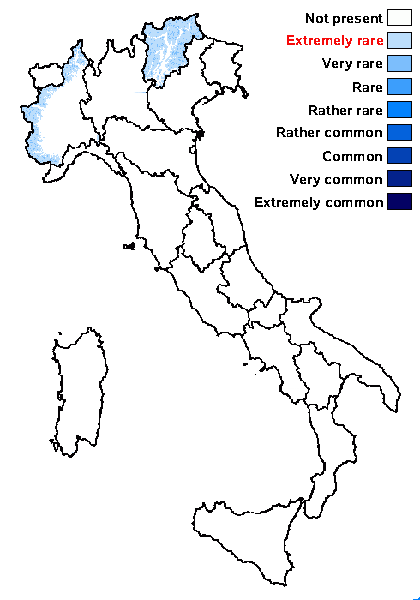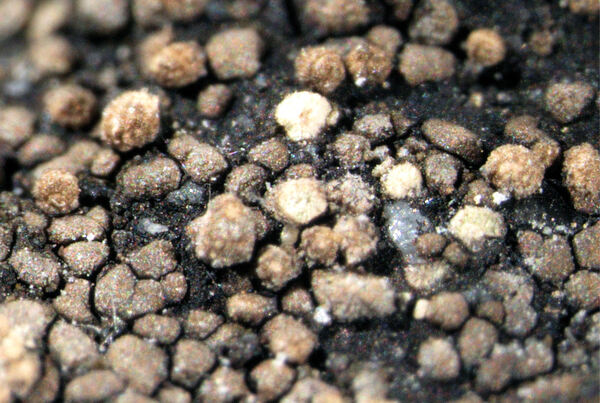Rimularia gibbosa (Ach.) Coppins, Hertel & Rambold
in Hertel & Rambold, Bibl. Lichenol., 38: 171, 1990. Basionym: Pyrenula gibbosa Ach. - Lichenogr. Univ.: 317, 1810.
Synonyms: Aspicilia bockii (T. Rödig) Boistel; Lecanora bockii T. Rödig; Lecanora grimselana A. Massal.; Mosigia gibbosa (Ach.) Körb.
Distribution: N - TAA (Nascimbene & al. 2022), Piem (Isocrono & al. 2004).
Description: Thallus crustose, episubstratic, 0.1-0.4 mm thick, of scattered to contiguous areoles developing on a black hypothallus, forming up to 6 cm wide patches. Areoles rounded to irregularly angular, pale grey-brown to beige, slightly to strongly convex or almost bullate, 0.4-0.5(-0.7) mm wide, each one bearing a 0.15-0.25 mm wide and up to 0.5 mm tall, papillose-isidioid outgrowth giving rise to a whitish, 0.2-0.5 mm wide soralium. Medulla white, I-. Apothecia sparse, lecanorine, 0.5-0.8(-1.2) mm across, often umbonate or gyrodisc, with an initially punctiform, then expanded, black, slightly convex disc, and a 0.1-0.3 mm thick, persistent thalline margin. Proper exciple dark brown in outer part, pale brown to colourless within, continuous with hypothecium; epithecium pale brown; hymenium colourless, but subdivided into portions by vertical, dark brown bundles of sterile hyphae, 90-110 μm high; paraphyses coherent, slender, richly branched and anastomosing; hypothecium dark brown, up to 350 μm high. Asci 8-spored, broadly clavate, the tholus with amyloid flanks and an amyloid cap with vestiges of a narrow, weakly amyloid channel in the upper, central part, Rimularia-type. Ascospores 1-celled, hyaline, turning brownish when overmature, ellipsoid, (14-)16-25(-30) x (8-)10-13(-14) μm. Pycnidia black, immersed. Conidia short-bacilliform. Photobiont chlorococcoid. Spot tests: thallus (especially medulla) K-, C+ pink, KC+ pink, P-, UV-. Chemistry: gyrophoric acid. Note: on steeply inclined surfaces of mineral-rich to basic siliceous rocks wetted by rain, often in seepage tracks, usually in upland areas. The species often produces both apothecia and soredia.
Growth form: Crustose
Substrata: rocks
Photobiont: green algae other than Trentepohlia
Reproductive strategy: mainly sexual, or asexual by soredia, or soredia-like structures (e.g. blastidia)
Commonnes-rarity: (info)
Alpine belt: extremely rare
Subalpine belt: very rare
Oromediterranean belt: absent
Montane belt: extremely rare
Submediterranean belt: absent
Padanian area: absent
Humid submediterranean belt: absent
Humid mediterranean belt: absent
Dry mediterranean belt: absent

Predictive model
Growth form: Crustose
Substrata: rocks
Photobiont: green algae other than Trentepohlia
Reproductive strategy: mainly sexual, or asexual by soredia, or soredia-like structures (e.g. blastidia)
Commonnes-rarity: (info)
Alpine belt: extremely rare
Subalpine belt: very rare
Oromediterranean belt: absent
Montane belt: extremely rare
Submediterranean belt: absent
Padanian area: absent
Humid submediterranean belt: absent
Humid mediterranean belt: absent
Dry mediterranean belt: absent

Predictive model
 Index Fungorum
Index Fungorum
 GBIF
GBIF





